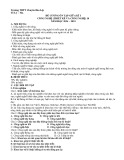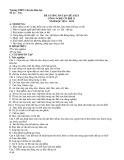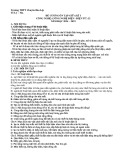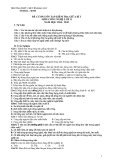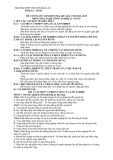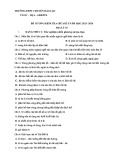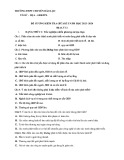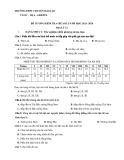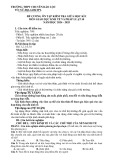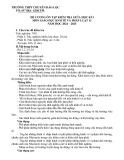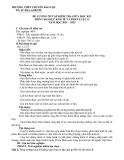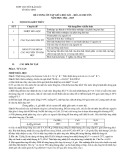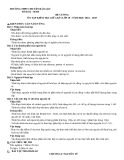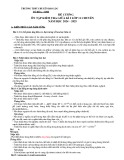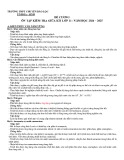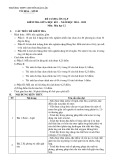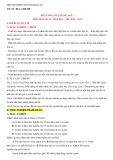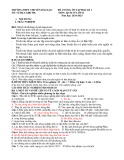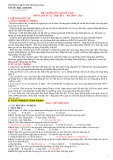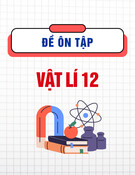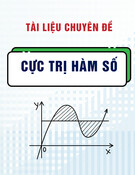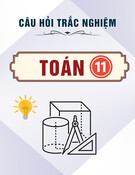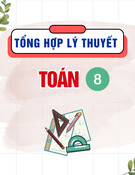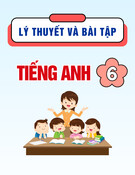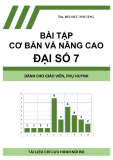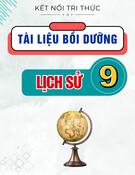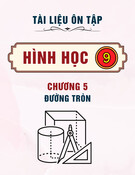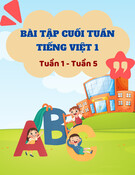Ề ƯƠ Ớ Ọ Ậ Ế Đ C NG ÔN T P MÔN TI NG ANH L P 6 NĂM H C 20222023
ỏ ở ừ ự ừ ọ
ệ ạ ơ i đ n (The simple present)
i đ n đ
ề ộ ườ ặ ộ i hàng ngày, nói v m t hành đ ng th ng xuyên
The sun sets in the west
ủ She plays basketball very well
I. Vocabulary T v ng unit 1,2,3 T tr ng tâm: take off: c i, b Share, enjoy, friend, sweep, bookshelf, floor, gym, balcony, laundry, center, literature, west, sky, adventure, wear, sign up, science club, sports club, novel, city, famous, expensive, long/short hair, blond, mall, think about, beach, teach, basement II. Grammar 1. Thì hi n t a. Cách dùng ệ ạ ơ ượ ử ụ ể c s d ng đ : Thì hi n t ặ ạ ề ộ + Nói v m t thói quen l p đi l p l ả I always get up at 6.am x y ra: ề ự ậ ể + Nói v s th t, chân lý hi n nhiên: ả ề + Nói v kh năng c a ai đó: ề ộ ở + Nói v m t s thích: I like English.
ị ấ ạ b. C u t o ẳ + Câu kh ng đ nh
ừ ST ộ Đ ng t to be ộ Đ ng t ừ ườ th ng
ừ ố ề s nhi u + ừ ố s ít/ Danh t ừ
ượ ế Công th cứ s ít/ Danh t ừ ừ ố ề s nhi u ượ ế S + V(s/es) I/ We/ You/ They/ Danh t V(nguyên th )ể He/ She/ It/ Danh t không đ m đ ừ ố c + V(s/es) S + am/ is/ are+ N/ Adj I + am He/ She/ It/ Danh t c + is không đ m đ You/ We/ They/ Danh t + are
ỉ ế ằ ng b ng xe
ấ
ạ ớ ng xuyên d y s m) Ví dụ ồ ấ ắ ề ế ồ
ỗ ố ấ i) ọ He is a lawyer. ậ ư ộ (Ông y là m t lu t s ) The watch is expensive. (Chi c đ ng h r t đ t ti n) They are students. (H là sinh viên)
ặ ờ ặ ở ướ I often go to school by bus ườ ả (Tôi th nh tho ng đ n tr buýt) He usually gets up early. ườ ấ (Anh y th She does homework every evening. ề (Cô y làm bài v nhà m i t The Sun sets in the West. (M t tr i l n h
ng Tây) ớ ớ ậ ừ
ướ ụ ừ ộ ớ ố c "y" là m t ph âm thì khi dùng v i ngôi s ít, có t n cùng là “y” , tr
ừ ớ ố có t n cùng là “o”, “ch”, “sh”, “x”, “s” , "z"thì khi dùng v i ngôi s ít, V i các t thêm đuôi “es”. (go – goes; do – does; watch – watches; fix – fixes, miss – misses, wash washes ) ậ ớ V i các t ổ đ i “y” thành "i" và thêm đuôi “es” ( ạ i, thêm đuôi “s”. ( V i các t còn l copy – copies; study – studies) see – sees; play – plays,…)
ừ
ọ ụ "have": S ( he/she/it) + has ả ừ ố ề s nhi u)
ượ ọ s/ c đ c là /
ượ ọ iz/ c đ c là /
ượ ọ ườ ạ z/ ợ ng h p còn l c đ c là / i s đ
ớ ộ V i đ ng t * Cách đ c đuôi "s/es" ( áp d ng cho c danh t + Có 3 cách đ cọ ụ Sau các ph âm k, p, t, f đuôi s/es đ Takes, laugh/f/ laughs ụ Sau các ph âm sh, ch, ss, z,x, ge,ce đuôi s/es đ Watches, misses Sau các tr plays
ừ ừ ỉ ộ ủ ị + Câu ph đ nh ( không) ộ Đ ng t “to be” ộ Đ ng t ch hành đ ng
Công th cứ S + am/are/is + not +......... S (I,we, you, they) + do+ not + V(nguyên th )ể S ( he,she, it)+ does + not + V(nguyên th )ể
is not = isn’t are not = aren’t Chú ý ế ắ t t (Vi t)
ế ườ ườ ng xuyên đ n tr
ộ Ví dụ ạ ớ ườ ng xuyên d y s m) I am not a teacher. Tôi không là gv ả (Tôi không ph i là m t giáo viên.)
ỗ ố ề ấ do not = don’t does not = doesn’t I do not (don’t) often go to school by bus ằ (Tôi không th ng b ng xe buýt) He does not (doesn’t) usually get up early. ấ (Anh y không th She does not (doesn’t) do her homework every evening. (Cô y không làm bài v nhà m i t i)
ắ ộ ạ ấ ng, các b n r t hay m c ph i l ả ỗ thêm “s” i
ộ
ố ớ ặ ủ ữ ể
ộ ừ ẫ “like” v n có
Câu đúng:
She doesn’t like chocolate. ỏ
ầ ừ ườ ủ ị Đ i v i câu ph đ nh, ph n đ ng t th ạ ừ. Các b n chú ý: ằ ho c “es” đ ng sau đ ng t Ch ng + don’t/ doesn’t + V (nguyên th không chia) Ví d :ụ Câu sai: She doesn’t likes chocolate. (Sai vì đã có “doesn’t” mà đ ng t đuôi “s”) → + Câu nghi v n ấ (Câu h i Yes/ No)
ừ ỉ ộ to “be” ộ Đ ng t ộ Đ ng t ch hành đ ng
Công th cứ ừ Q: Am/ Are/ Is (not) + S + ………? A: Yes, S + am/ are/ is. No, S + am not/ aren’t/ isn’t.
Q: Do/ Does + S + V (nguyên th )?ể A: Yes, S + do/ does. No, S + don’t/ doesn’t. Q: Does she go to work by taxi? Ví dụ Q: Are you a engineer?
ạ ằ ả kỹ sư không?
ả (B n có ph i là A: Yes, I am. (Đúng v y)ậ No, I am not. (Không ph i)ả (Cô yấ đi làm b ng taxi ph i không?) A: Yes, she does. (Có) No, she doesn’t. (Không)
ỏ ừ ể ỏ + Câu h i có t
ừ ừ ỉ ộ đ h i Wh ộ Đ ng t to “be” ộ Đ ng t ch hành đ ng
Wh + am/ are/ is + S + …..? Công th cứ
ạ ế ừ ế ừ ạ đâu?) Ví dụ ạ ọ Where are you from? (B n đ n t đâu?) Who are they? (H là ai?) Wh + do/ does + S + V (nguyên th )ể …? Where do you come from? (B n đ n t ề What do you do? (B n làm ngh gì?)
ế ệ ạ ơ ừ ậ * T nh n bi t thì hi n t i đ n
always/ usually/ often/ sometimes/ occasionally/ seldom/never …. Everyday/ week/ month/year….,once a week, twice a year…
ạ ừ ở ữ s h u
ệ ạ ế ễ i ti p di n (The present continuous tense).
ộ ả ạ ờ ể m t hành đ ng đang x y ra t i th i đi m nói
ị 2. Đ i t Mine, yours , ours, hers, his, theirs, its 3. Thì hi n t a. Cách dùng ễ ả ộ Di n t ấ ạ b. C u t o ẳ + Câu kh ng đ nh
Công th cứ ế ượ c + is + Ving
ừ s ít/ Danh t ừ ố s nhi u không đ m đ ề + are + Ving
ọ S + am/ is/ are + Ving I + am + Ving ừ ố He/ She/ It/ Danh t You/ We/ They/ Danh t I am studying Math now. (Tôi đang h c toán.) Ví dụ
ớ ạ ậ ừ ẽ ỏ có t n cùng là “e”, khi chuy n sang d ng ing thì s b đuôi “e” và thêm
ớ ậ ể ừ Ẫ ạ có t n cùng là “ee” khi chuy n sang d ng ing thì V N GI Ữ
ớ
ướ ừ ừ ế ằ ộ ộ c là m t
ướ stop – stopping; run – running)
ồ k t thúc là “ie” thì khi thêm “ing”, thay “ie” vào “y” r i thêm “ing”. ( lie –
ủ ị
ể V i các t “ing” luôn. (use – using; pose – posing; improve – improving; change – changing) V i các t NGUYÊN “ee” và thêm đuôi “ing”. (knee – kneeing) ồ ắ ấ ụ Quy t c g p đôi ph âm r i m i thêm ing: ụ ế ế ộ t k t thúc b ng m t ph âm (tr h, w, x, y), đi tr + N u đ ng t có 1 âm ti ụ ấ nguyên âm ta g p đôi ph âm tr c khi thêm “ing. ( ừ ế ộ Đ ng t lying; die – dying) + Câu ph đ nh Công th cứ S + am/are/is + not + Ving
Chú ý ế ắ t t (Vi t)
ờ ữ ố ấ tôi không n u b a t i.) is not = isn’t are not = aren’t I am not cooking dinner now. (Bây gi Ví dụ
ỏ
+ Câu nghi v n ấ (Câu h i Yes/ No)
Công th cứ
ụ ả ạ
Ví dụ ạ ấ ơ
ả
ừ ể ỏ ỏ
Q: Am/ Is/ Are + S + Ving? A: Yes, S + am/is/are. No, S + am/is/are + not. ả Q: Are you taking a photo of me? (B n đang ch p nh tôi ph i không?) A: Yes, I am. Q: Is she going out with you? (Cô y đang đi ch i cùng b n có ph i không?) A: No, she isn’t. + Câu h i có t đ h i Wh Công th cứ Wh + am/ are/ is + S + Ving?
ạ ậ Ví dụ ậ ọ What are you doing? (B n đang làm gì v y) What is he studying right now? (Anh ta đang h c gì v y)
t:
ệ ấ ậ ế ế ậ ệ ấ * D u hi u nh n bi ễ ệ ạ ế Thì hi n t i ti p di n có các d u hi u nh n bi ư t nh sau:
ừ ỉ ờ ạ Tr ng t ch th i gian:
ệ ạ i
ờ ụ ể + now (It’s 12 o’lock now)
ả ừ ầ trên c u xu ng!)
Trong câu có các đ ng ộ ừ ư nh : t
Now: Bây giờ Right now: Ngay bây giờ At the moment: Ngay lúc này At present: Hi n t It’s + gi c th Look!/ Watch! (Nhìn kìa!) VD: Look! A girl is jumping from the bridge! ố (Nhìn kìa! Cô gái đang nh y t Listen! (Nghe này!) VD: Listen! Someone is crying! (Nghe này! Ai đó đang khóc.)
ố
ỏ ề ộ ố ẫ * M t s m u câu: Want to + V…. mu n ( làm gì) Would like to + V… mu nố Like + ving: thích làm gì There is / are…… Có What do/does + S + look like ? câu h i v hình dáng
PHONETICS
D. summer D. transportation D. write D. attention
C. serve C. question C. think C. basement
B. seafood B. population B. listen B. garage
D. wearing
B. teaching
C. cleaning
D. parks
B. groups
C. markets
D. schools
C. buildings
B. apartments
C. houses
B. temples
D. families
D. doesn’t
C. don’t
B. not
C. aren’t
D. do
D. is sit
C. sit
D. is mean
C. mean
D. doesn’t
B. isn’t
D. not
B. do
C. is
D. isn’t drink
C. is drink
B. drink
D. have
B. are
C. is
D. doesn’t grow
C. grows
B. grow
D. doesn’t be
C. are
III. Bài t pậ ❶ Choose the words whose underlined part is pronounced differently from that of the others in each group. 2. A. island 3. A. information 4. A. live 5. A. delta 6. A. speaking 7. A. farmers 8. A. museums 9. A. stores 2. Fill in the blanks with the correct form of the verbs. 1. My mom always (make)__________ delicious meals. 2. Jenifer (not eat)__________ eggs every day 3. They (go)__________ shopping twice a week. 4. __________ Minh and Hoa (go)__________ to work by bus every day? 5. we ( do ) the laundry now. 6. Where__________ he (come)__________ from? 7. Mai ( dance) __________ now. 8. Mary ( be) __________ beautiful. 3. Choose the correct word/phrase (A, B, C or D) to complete the sentence. 1. I _________ know the correct answer. A. am not 2. They _________ agree with my opinion. A. are B. don’t 3. Kathy usually _________ in front of the window during the class. A. sits B. sitting 4. What does this word _________? B. meaning A. means 5. He _________ share anything with me. A. don’t do C. not 6. I come from Canada. Where _________ you come from? A. are 7. Jane _________ tea very often. A. doesn’t drink 8. How often _________ you play tennis? A. do 9. They _________ rice in pleasant climates. A. are grow 10. I _________ tall A. am B. grow up 11. I would like …………. The shopping A. do B. does C. to do D. doing 12. My friend ……………reading books now. A. does B. are C. is D. do
4. Write a new sentence as similar as possible in meaning to the original sentence 1. He has a small nose. His nose…………………………………………………………………… 2. There are 15 members in her club. Her club…………………………………………………………………… 3. His mother works in a factory. His mother is…………………………………………… 4. Does your class have 30 students ? are there………………………………………………………?
5. Make meaning sentences using the following suggested words 1. She / want / do / dishes. …………………………………………………………………………………… 2. They / not / draw / picture / every week. …………………………………………………………………………………………… 3. His father / like / watch / news ……………………………………………………………………………………… 4. Hai / listen /music / now. …………………………………………………………………………………………… 5. I / short and fat. ............................................................................................................................................
* Đáp Án
PHONETICS
❶ Choose the words whose underlined part is pronounced differently from that of the others in each group. *key: 1A 2.C 3.D 4C 5.D 6.A 7. B 8.C 2. Fill in the blanks with the correct form of the verbs. 1. My mom always makes delicious meals. 2. Jenifer does not eat eggs every day 3. They go shopping twice a week. 4. Do Minh and Hoa go to work by bus every day? 5. we are doing the laundry now. 6. Where does he come from? 7. Mai is dancing now. 8. Mary are beautiful. 3. Choose the correct word/phrase (A, B, C or D) to complete the sentence. 1.C 2. B 3. A 4.C 5.D 6.B 7.A 8.A 9.B 10.A 11.C 12.C 4. Write a new sentence as similar as possible in meaning to the original sentence 1. He has a small nose.
His nose is small 2. There are 15 members in her club. Her club has 15 members 3. His mother works in a factory. His mother is a worker in a factory 4. Does your class have 30 students ? are there 30 students in your class?
5. Make meaning sentences using the following suggested words 1. She / want / do / dishes. She wants to do the dishes. 2. They / not / draw / picture / every week. They don't draw pictures every week. 3. His father / like / watch / news His father likes watching the news 4. Hai / listen /music / now. Hai is listening to music now. 5. I / short and fat. I am short and fat.


